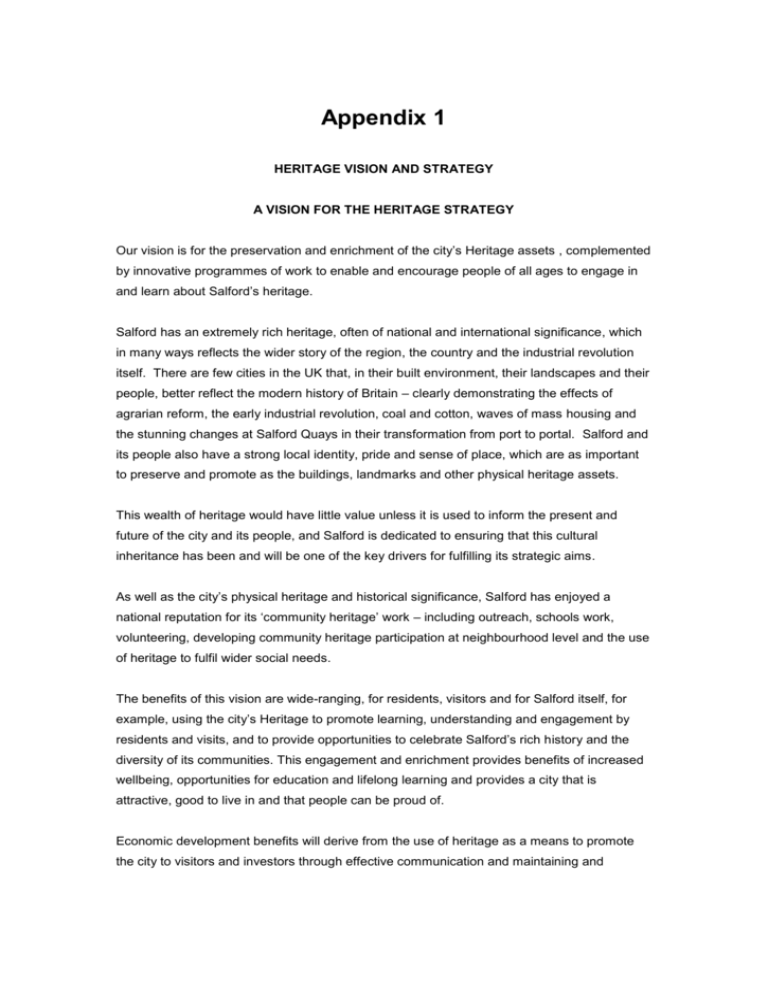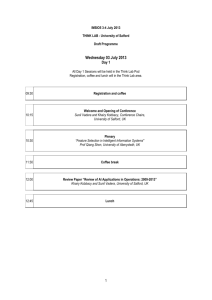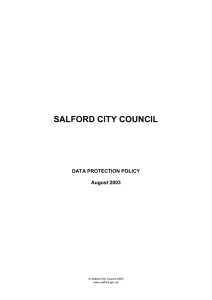HERITAGE VISION AND STRATEGY * DRAFT 17/2/11
advertisement

Appendix 1 HERITAGE VISION AND STRATEGY A VISION FOR THE HERITAGE STRATEGY Our vision is for the preservation and enrichment of the city’s Heritage assets , complemented by innovative programmes of work to enable and encourage people of all ages to engage in and learn about Salford’s heritage. Salford has an extremely rich heritage, often of national and international significance, which in many ways reflects the wider story of the region, the country and the industrial revolution itself. There are few cities in the UK that, in their built environment, their landscapes and their people, better reflect the modern history of Britain – clearly demonstrating the effects of agrarian reform, the early industrial revolution, coal and cotton, waves of mass housing and the stunning changes at Salford Quays in their transformation from port to portal. Salford and its people also have a strong local identity, pride and sense of place, which are as important to preserve and promote as the buildings, landmarks and other physical heritage assets. This wealth of heritage would have little value unless it is used to inform the present and future of the city and its people, and Salford is dedicated to ensuring that this cultural inheritance has been and will be one of the key drivers for fulfilling its strategic aims. As well as the city’s physical heritage and historical significance, Salford has enjoyed a national reputation for its ‘community heritage’ work – including outreach, schools work, volunteering, developing community heritage participation at neighbourhood level and the use of heritage to fulfil wider social needs. The benefits of this vision are wide-ranging, for residents, visitors and for Salford itself, for example, using the city’s Heritage to promote learning, understanding and engagement by residents and visits, and to provide opportunities to celebrate Salford’s rich history and the diversity of its communities. This engagement and enrichment provides benefits of increased wellbeing, opportunities for education and lifelong learning and provides a city that is attractive, good to live in and that people can be proud of. Economic development benefits will derive from the use of heritage as a means to promote the city to visitors and investors through effective communication and maintaining and enhancing Salford’s heritage offer through preservation and enrichment of its key heritage assets. SALFORD’S STORY Pre-Industrial Salford Salford began life as a village on the banks of the River Irwell; the earliest mention of the Salford Hundred occurs in the Domesday Book, where it is recorded that King Edward the Confessor had held the Manor (or Hundred) in 1066 when it was mostly forest land. The Hundred of Salford stretched from the Mersey to Rossendale and was to form the south east part of Lancashire when this came to be officially regarded as a separate county in the 12th century. However, pre-historic finds in the parish of Eccles include dugout boats found at Barton-upon Irwell, and an arrowhead, a spear and axes at Winton, appear to suggest the existence of human habitation in the area as far back as 6000 BC, with two separate periods of settlement on Chat Moss, the first around 500 BC and the second during the Roman occupation of Britain. Ordsall Hall dates back over 820 years. Throughout history it has been put to many uses - a family home, working men's club and church hall. The most important period of its life is undoubtedly as the family seat of the Radclyffe family who resided there for over 300 of those years. There was probably a house at Ordsall by 1251 when William de Ferrers, Earl of Derby, exchanged the manor for land in Pendleton which belonged to David de Hulton. Ten years later he had enlarged his house which included a new chapel for which he received a licence in 1361. The Hall has been altered and extended a number of times through the ages, significantly in 1512 with the building of the Great Hall, and in the 17th century when a brick house was built at the west end of the house. Later the house was joined to the main building. The hall was purchased by Salford Corporation from the Executors of the Baron Egerton of Tatton in 1959 and, following major restoration work, was finally opened to the public in April 1972 as a period house and local history museum. In 2011, the Hall will re-open to the public after a major programme of restoration. Building the 19th Century City / The rise of Salford Salford’s rise to industrial status must have seemed dizzyingly fast to anyone who lived through it. If you had stood on the streets of Salford in 1820 and rewound back in time a couple of generations you would have found yourself very quickly in a small country town surrounded by streams, woods and fields. Within the town would have been dozens of cottonspinners working from their own homes. It was the chance combination of climate, coal and water – all ingredients necessary for the industrial revolution - that made Salford and the industrial world what it is, but it was the invention of the steam-powered spinning wheel which was the spark that lit the flames, as entrepreneurs like the Duke of Bridgewater very quickly saw. Steam required coal, which Salford had in abundance thanks to the coal seams exposed by the Irwell Valley fault, and with access to it in various locations, including Pendleton, Clifton and Worsley. It also had water that it took from the Irwell. Very rapidly the first cotton mills began sucking in workers from the impoverished countryside. They came in waves, first from the poorer parts of Lancashire and Cheshire, later from Ireland and from Europe. The Bridgewater Canal ran for some forty-seven miles underground, penetrating deep into the seams of the Worsley Coalfield. It was designed to carry coal to Manchester and Salford, and crossed the Irwell spectacularly by an aqueduct at Barton. The canals cut costs and boosted profits still further. They linked Salford (Worsley) to Manchester and Liverpool and from there out across the world. This is a story of massive investment (from the Duke of Bridgewater) and innovative engineering (from Brindley and Gilbert) which sparked the industrial revolution across the world. By using cheap coal and new transport networks it made Salford and Worsley the cradle of the industrial revolution and was the biggest of Salford’s many ‘firsts’. The new industries prompted the transport revolution. Salford was at the forefront with the Bridgewater Canal (1761), Britain’s first major canal that instigated the subsequent nationwide canal network. Later this was superseded by the railways. Salford was crossed by the world’s first passenger railway, the Liverpool-Manchester railway (1830). Alongside the mills came also the growth in the mines and the engineering factories. James Nasmyth, considered to be the inventor of the steam hammer, built the Bridgewater Foundry in Patricroft in 1836, which soon became a major manufacturer of steam locomotives. Salford and the world In the second half of the nineteenth century Salford’s economy matured, with the old dominance of cotton beginning to weaken and textile firms starting to specialise in order to survive. Engineering also grew in importance. The rural pockets that had marked out Salford in the early nineteenth century diminished in number and immigrants arrived from Ireland, the Middle East (the Yemen in particular), Africa, Poland, Scandinavia and many more countries. Between 1881 and 1914 there was a mass influx of Jewish immigration from Eastern Europe and the first half of the twentieth century continued to see an influx of people from across the world into Salford, people who are integral to the story of Salford and who make up the many communities that live in the city today. At the end of the nineteenth century a group of local businessmen decided to build a ship canal, to bypass the stranglehold of Liverpool and run from Manchester through Salford to the sea. When the Manchester Ship Canal opened in 1894, Manchester and Salford became the fourth largest port in the UK, ushering in a period of prosperity for Salford that lasted into the twentieth century. New ideas emerged as to what constituted a city fit to live in. Joseph Brotherton, the liberal MP for Salford, campaigned amongst others for Salford to have a free and universally accessible museum, library and art gallery. Salford’s public library was the first free, municipal library in the world. By 1857 Salford Museum had more visitors than the British Museum. During the second half of the nineteenth century Salford exported its products round the world. Amongst these products Pilkington can stand for the best that Salford ever produced. Pilkington ware was characterised by the use of only the best artists and craftsmen, and by the discovery of a series of new and unusual glazes. Twentieth century Salford In the First World War entire battalions were created from young men who all enlisted from neighbouring streets. Three battalions of Salford Pals fought together at the Battle of the Somme. Their destruction meant the end of a community and a way of life. The First World War brought an end to the Edwardian era and ushered in the turbulent years of the 1920’s and the 1930’s. The world economy fell into a slump, the effects of which soon reached Salford. The Manchester Ship Canal brought prosperity for some, but soon textile production in Salford was undercut by cheaper goods from overseas. Heavy engineering took its place, only to be undercut in its turn. As coal and cotton collapsed, unemployment rose and generations of families in Salford who had lived in terrible poverty in the nineteenth century found that things got no better, indeed probably got worse, in the twentieth century. The Second World War changed everything, helping the government see the evils of dirt, ignorance, want and disease and underlining the need for a healthy population. The Beveridge Report of 1942 paved the way for the birth of the Welfare State, which laid the foundations for the social changes of the 1960s and 70s. However, problems soon became apparent, especially with the programme of slum clearances in the inner cities introduced by the 1947 Comprehensive Development Act in the belief that the problems of the city, including its endemic poverty, could be solved by changing the housing fabric. By the late 1960s disenchantment with the slum clearances was growing. Redevelopment struggled to keep pace so housing shortages arose; communities were broken up and those communities that had greeted the first slum clearances with approval were now resisting them. Vast tracts of derelict land brought their own issues of decline, further exacerbated as the old manufacturing industries declined and unemployment rose. Through his paintings, drawing and photography L.S Lowry charted the industrial and social landscapes of the city and the north of England during much of the twentieth century. Lowry recalled, "At first I detested it, and then, after years I got pretty interested in it, then obsessed by it." His paintings were of street scenes and townscapes, children playing in the streets, people walking to and from work, gossip on the front steps, factories and mills, bombed-out houses during the blitz. In later life he recalled, "The huge black framework of rows of yellow-lit windows standing up against the sad, damp charged afternoon sky. The mill was turning out... I watched this scene - which I'd looked at many times without seeing - with rapture..." Modern Salford A further programme of regeneration commenced in the city in the late twentieth century, centred on, but not confined to, Salford Quays. Salford Docks had suffered from the decline of heavy industry and was finally closed in 1982, leaving the disused piers and waterways at risk of becoming a wasteland. In 1985 the Salford Quays Development Plan was unveiled, leading to the development and creation of the Lowry, the Imperial War Museum North across the water in Trafford, and the eventual creation of MediaCityUK. In 1988, a new arts centre, based at Pier 8, was proposed to raise the cultural profile of the city and bring more businesses and tourism into the area. Salford City Council commissioned the internationally famous architects James Stirling and Michael Wilford to produce designs for the arts centre. Stirling died suddenly in 1992, and Wilford was confirmed as architect. Lottery funding was secured, building began in April 1997, and The Lowry was completed three years later in 2000. The Lowry collection was transferred to the new centre from Salford Museum and Art Gallery, which had been collecting Lowry’s work since the 1930s. The collection at the Lowry comprises around 400 items, including oil paintings, drawings, pastels and watercolours, representing all periods of LS Lowry’s career, from early still life studies and life drawings, to industrial landscapes and later, small, figure groups. The LS Lowry archive at The Lowry includes a wide range of material, compiled largely by Salford Museum and Art Gallery, including a comprehensive collection of exhibition catalogues for exhibitions held both during Lowry’s lifetime and subsequently, press cuttings relating to the artist, audio and video material including interviews, letters to and from LS Lowry, photographs, ephemera, auction catalogues, books and information on works by LS Lowry in the collection at The Lowry and elsewhere. Since then, Salford Quays has further developed into a major focus for culture, leisure, economic development and regeneration, culminating in the development of MediaCityUK and completing the City’s transformation from port to portal. AIMS Salford’s Heritage programme has the following three key aims: To ensure the custodianship of Salford’s heritage To improve the quality of life for the city’s residents To attract visitors and investment to Salford






